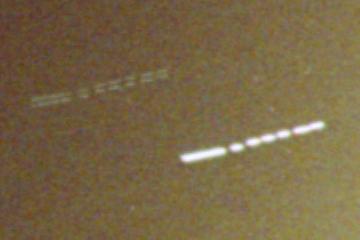
Robert Reeves suggests testing the focus of your lenses as the infinity mark cannot always be trusted. This isn’t necessarily because the manufacturer was sloppy; certain long focal-length lenses may significantly affected by temperature and at some temperatures they will focus beyond infinity (Buzz Lightyear, take note).
I decided to do a quick test of the 50-mm f/2 lens on my Pentax A3000. The test involves making a Hartman mask for the lens and shooting a set of star trails, each with a slightly different focus. The first step was to print a small label with lines at intervals of about 2-mm which I could attach to the camera lens where the distance calibration marks are located. This allows me to carefully turn the focus ring in steps of about 1-mm. I focused, per Reeves’ suggestion, starting from the closer settings toward infinity, stepping 1/2-mark without ever backing up to insure that the gear mechanism is fully engaged with no backlash.
I used Lyra as my target area simply because it was roughly overhead at the time which allows me to easily point without having any local street lights shine into the camera. Since my camera does not allow multiple exposures on the same frame, I used the “hat-trick” though in my case it was a black fleece glove. The first exposure was for 60-seconds. I then covered the lens with the glove and adjusted the focus ring. I then took a 30-second exposure and repeated. Making the first exposure longer than the others allows you to easily tell from the resulting photo which end is the starting point.

| Object | Vega and Epsilon Lyra |
| Location | Forest Hills, NY |
| Time | 2001 Aug 30 0300 UT |
| Camera | Pentax A3000, 50 mm f/2 lens |
| Film | Fuji Superia X-tra, ISO 800 |
| Exposure | First trail is 60-seconds, subsequent trails are 30-seconds each |
| Comments | Highly enlarged section. A gentle unsharp mask was applied. North is roughly up; the stars are trailing to the west (right). |
Below is a close-up of one section of the print showing Vega and Epsilon Lyrae. What I expected to see was a series of double trails for each star. Each pair would be closer together than the previous pair with them eventually converging into a single trail and possibly spreading apart again. Since I only see one trail (the double trail for the upper star is because Epsilon Lyrae is a double; there really are two stars there), my tentative conclusion is that focusing is not very critical for a 50-mm lens.
However, I’m not quite willing to stand on that just yet. Among other things, I’m not sure about the orientation of the Hartman mask so it is possible that the reason that I don’t see two trails is because they are co-linear instead of being parallel; i.e., maybe I need to rotate the mask 90-degrees and try again.
References
- Wide Field Astrophotography, Robert Reeves, copyright © 2000, published by Willmann-Bell, Inc.
Written by Roland Roberts
Search
.Archives
- October 2024 (1)
- May 2024 (2)
- April 2024 (3)
- September 2022 (5)
- April 2022 (1)
- January 2022 (3)
- December 2021 (4)
- September 2021 (3)
- July 2021 (1)
- January 2021 (1)
- November 2020 (2)
- October 2020 (2)
- September 2020 (2)
- August 2020 (5)
- July 2020 (1)
- November 2019 (2)
- September 2019 (1)
- August 2019 (2)
- September 2017 (1)
- August 2017 (1)
- September 2015 (3)
- August 2015 (2)
- June 2015 (5)
- May 2015 (3)
- May 2013 (2)
- January 2013 (1)
- December 2012 (2)
- September 2012 (1)
- June 2012 (1)
- May 2012 (1)
- October 2011 (2)
- September 2011 (2)
- April 2011 (2)
- March 2011 (10)
- January 2011 (8)
- November 2010 (2)
- October 2010 (1)
- September 2010 (3)
- August 2010 (2)
- July 2010 (1)
- June 2010 (1)
- April 2010 (3)
- February 2010 (3)
- January 2010 (3)
- December 2009 (6)
- November 2009 (3)
- October 2009 (7)
- September 2009 (8)
- August 2009 (4)
- July 2009 (1)
- June 2009 (2)
- May 2009 (2)
- April 2009 (7)
- March 2009 (1)
- February 2009 (6)
- January 2009 (4)
- December 2008 (4)
- November 2008 (3)
- October 2008 (11)
- September 2008 (4)
- August 2008 (5)
- July 2008 (5)
- June 2008 (2)
- April 2008 (4)
- March 2008 (18)
- February 2008 (9)
- November 2007 (1)
- October 2007 (3)
- July 2007 (3)
- April 2007 (1)
- March 2007 (6)
- February 2007 (3)
- December 2006 (3)
- October 2006 (4)
- September 2006 (1)
- July 2006 (5)
- May 2006 (10)
- April 2006 (9)
